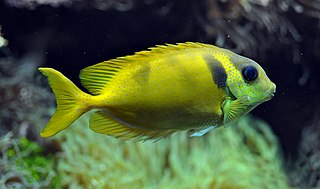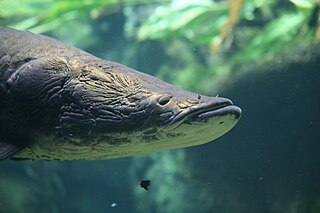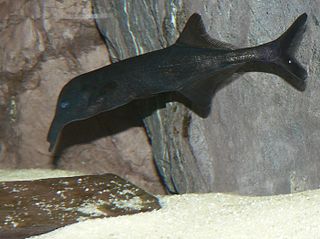
Clupeiformes is the order of ray-finned fish that includes the herring family, Clupeidae, and the anchovy family, Engraulidae. The group includes many of the most important forage and food fish.

Osteoglossiformes is a relatively primitive order of ray-finned fish that contains two sub-orders, the Osteoglossoidei and the Notopteroidei. All of at least 245 living species inhabit freshwater. They are found in South America, Africa, Australia and southern Asia, having first evolved in Gondwana before that continent broke up.

Hiodontiformes is a proposed order of fish consisting of the two living species of the mooneye family, Hiodontidae, and three extinct genera.

Hiodontidae, commonly called mooneyes, is a family of ray-finned fish with a single included genus Hiodon. The genus comprise two living species native to North America and three to five extinct species recorded from Paleocene to Eocene age fossils. They are large-eyed, fork-tailed fish that superficially resemble shads. The vernaular name comes from the metallic shine of their eyes.

Arowanas are freshwater bony fish of the family Osteoglossidae, also known as bony tongues. In this family of fish, the head is bony and the elongated body is covered by large, heavy scales, with a mosaic pattern of canals. The dorsal and anal fins have soft rays and are long based, while the pectoral and ventral fins are small. The name "bonytongues" is derived from a toothed bone on the floor of the mouth, the "tongue", equipped with teeth that bite against teeth on the roof of the mouth. The arowana is a facultative air breather and can obtain oxygen from air by sucking it into its swim bladder, which is lined with capillaries like lung tissue.

Neopterygii is a subclass of ray-finned fish (Actinopterygii). Only a few changes occurred during the evolution of neopterygians from the earlier actinopterygians. They appeared sometime in the Late Permian, before the time of the dinosaurs. The neopterygians were a very successful group of fish, because they could move more rapidly than their ancestors. Their scales and skeletons began to lighten during their evolution, and their jaws became more powerful and efficient. While electroreception and the ampullae of Lorenzini are present in all other groups of fish, with the exception of hagfish, neopterygians have lost this sense, even if it has later been re-evolved within Gymnotiformes and catfishes, which possess nonhomologous teleost ampullae.

Osteoglossomorpha is a group of bony fish in the Teleostei.

Scleropages is a genus of fish in the family Osteoglossidae found in Asia and Australia. All of these species are carnivorous and have great jumping ability. These species are highly valued as aquarium fish, particularly by those from Asian cultures. In 2003, a study redescribed several naturally occurring color varieties of S. formosus into four separate species. The majority of researchers dispute these redescriptions, arguing that the published data are insufficient to justify recognizing more than one Southeast Asian species of Scleropages and that divergent haplotypes used to distinguish the color strains into isolated species were found within a single color strain, contradicting the findings. They are considered monotypic, consisting of closely related haplotypes based on color. The ancestor of the Australian arowanas: S. jardinii and S. leichardti, diverged from the ancestor of the Asian arowanas about 140 million years ago, during the Early Cretaceous period. The morphological similarity of all seven species shows that little evolutionary change has taken place recently for these ancient fish. The genus had a much wider distribution during the early Cenozoic, with fossil remains known from the Paleocene of Niger and Belgium, and from the Eocene of China

The freshwater butterflyfish or African butterflyfish, Pantodon buchholzi, is the only species in the family Pantodontidae within the order Osteoglossiformes. It is not closely related to saltwater butterflyfishes.

Thrissops is an extinct genus of teleost fish from the Jurassic and Cretaceous periods. Its fossils are known from the Solnhofen limestone, as well as the Kimmeridge clay.
Notopteroidei is a suborder of the order Osteoglossiformes that contains the Gymnarchidae (aba), Notopteridae, mormyrids, as well as extinct families.

Gymnarchus niloticus – commonly known as the aba, aba aba, frankfish, freshwater rat-tail, poisson-cheval, or African knifefish – is an electric fish, and the only species in the genus Gymnarchus and the family Gymnarchidae within the order Osteoglossiformes. It is found in swamps, lakes and rivers in the Nile, Turkana, Chad, Niger, Volta, Senegal, and Gambia basins.
Occithrissops is an extinct genus of prehistoric ray-finned fish of the Jurassic, known for its fearsome yet small appearance. The genus name of Occithrissops derives from the Latin word "Occi" (killing) and the Greek words "thriss" (fish) and "ṓps" (“face”). Similar in relationship to the Thrissops, it was a slightly larger predatory teleost fish with serrated pelvic fins, a cleft tail, and a bony tongue similar to the Arapaima and formerly mentioned Thrissops, bearing small teeth for catching small slippery prey like squid, invertebrates and fish. The bony tongue assisted the fish in consuming hard shelled invertebrates which included small nektonic Jurassic ammonites, which despite the growing decline of ammonoids were still prevalent and plentiful for their time.

The subfamily Mormyrinae contains all but one of the genera of the African freshwater fish family Mormyridae in the order Osteoglossiformes. They are often called elephantfish due to a long protrusion below their mouths used to detect buried invertebrates that is suggestive of a tusk or trunk. They can also be called tapirfish.

Jamming avoidance response (JAR) is a behavior performed by some species of weakly electric fish. The JAR occurs when two electric fish with wave discharges meet – if their discharge frequencies are very similar, each fish will shift its discharge frequency to increase the difference between the two fish's discharge frequencies. By doing this, both fish prevent jamming of their sense of electroreception.

Campylomormyrus is a genus of elephantfish in the family Mormyridae.

The Quiricó Formation is a geological formation of the Areado Group in Minas Gerais, Brazil whose strata date back to the Lower Cretaceous. Many occurrences of fossils are reported in the lacustrine deposits of the Quiricó Formation.
The Myanmar arowana, Batik Arowana, is a large, bony-tongued fish native to Myanmar. The species is found in the Tananthayi River basin on the Indian Ocean coast of peninsular Myanmar.
Louise Schilthuis, also known as Lubbina Schilthuis, was a Dutch zoologist and a curator at the Zoology Museum at the University of Utrecht. She was active in the late 19th century and published at least two papers, both describing new species, on the specimens collected in the Congo by M.A. Greshof, a Dutch collector and trader, on the amphibians in 1889 and on the fishes on 1891. Boulenger named the mormyrid Marcusenius schilthuisiae after her.













